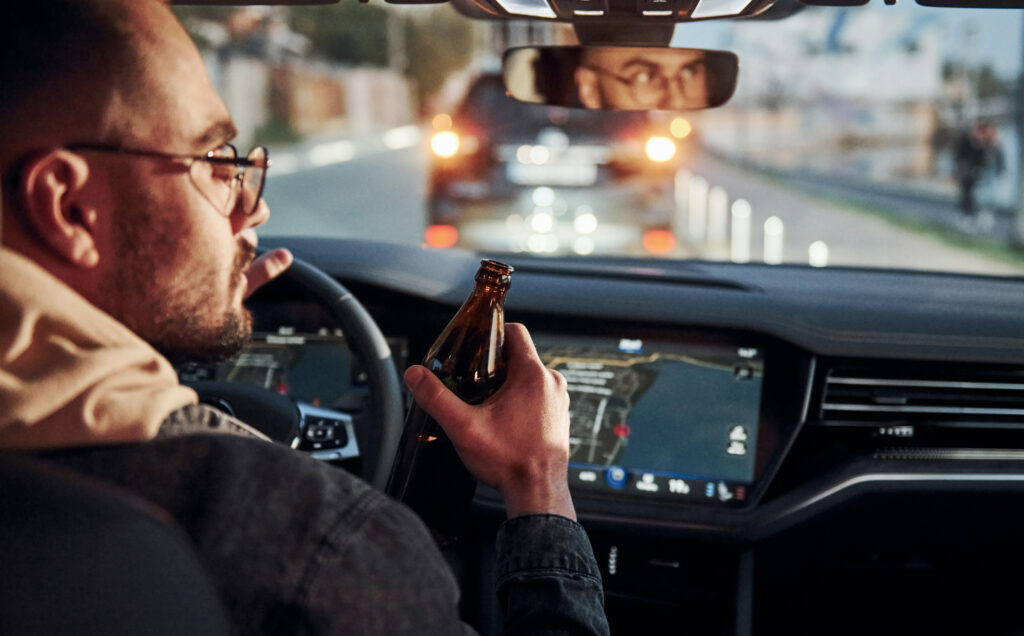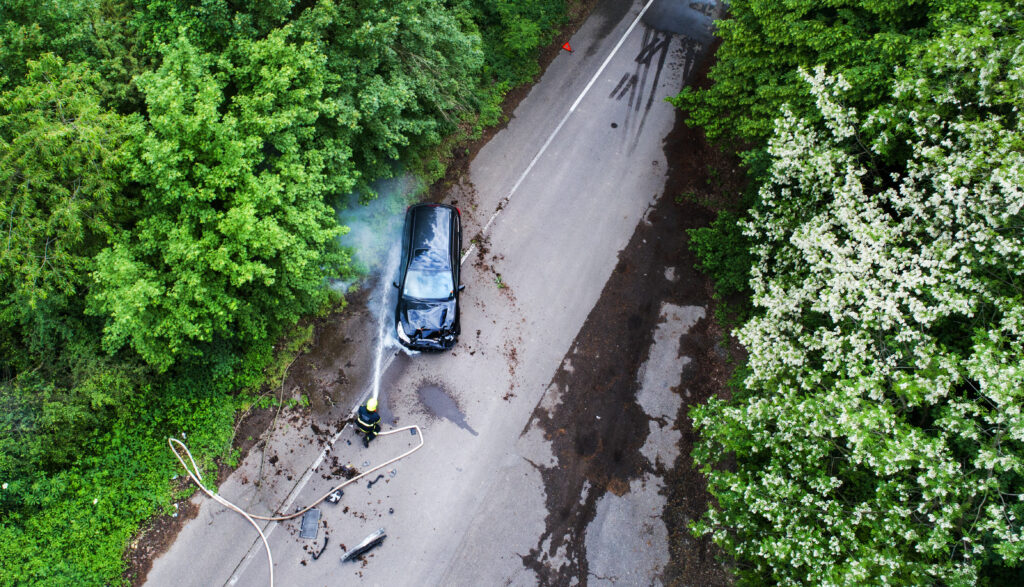Leading Causes of Car Accidents: Top 29 Car Crash Causes in Georgia
Feb 23, 2024 - Car Accidents
As you’d might expect, speeding and drunk driving are up there as leading causes of car accidents in Georgia. However, other car accidents occur due to running red lights, tailgating, and more.
While most of the accidents are caused by human error/decisions, let’s look into them in more detail and see what the number one cause of car accidents is each year in the Peach State.

What is the leading cause of vehicle accidents in Georgia
Which is the most common cause of traffic crashes? Well, the majority of crashes are caused by driver distraction. From text messaging to inattention to road surroundings, these lapses significantly increase the likelihood of vehicle collisions and fatal accidents, especially among teenagers and young adults.
Moving beyond driver distractions, there are several other key contributors to the high rate of road accidents in Georgia. Weather conditions, vehicle malfunctions, and road infrastructures play influential roles.
If you’re in Georgia and have been injured in a car accident that wasn’t your fault, contact a Johns Creek personal injury lawyer today for a free consultation.
Leading causes of car accidents caused by the driver
Other leading causes of car accidents each year include inexperienced drivers, wrong turns, eating while driving, which are all related to the leading cause of distracted driving and not paying attention to the surroundings and increasing the collision risk.
Of course, there are other driver-related factors as well that contribute to car crashes, and in the subsequent sections, we’ll take a closer look at each one of them and how they affect road safety in Georgia.
1. Distracted driving
Distracted driving continues to top the list as the leading cause of car accidents, silently affecting all demographics. This issue knows no bounds in Georgia, impacting both experienced drivers and beginners equally.
In fact, according to the Georgia Department of Transportation, distracted driving was responsible for 58% of all motor vehicle traffic crashes in the state. This underscores the importance of being a focused driver and avoiding distractions while behind the wheel. It follows that many types of personal injury cases in Georgia involve distracted driving, ranging from texting and driving to adjusting the radio, conversing and looking at passengers in the back seat, etc.
Additional reading: common car accident injuries
2. Speeding
What is the number two cause of collisions? Well, that would be speeding. While it may seem like a harmless violation, exceeding the speed limit can have serious consequences on the road. Speeding not only reduces reaction time but also increases the severity of an accident and the likelihood of fatalities.
According to the National Highway Traffic Safety Administration (NHTSA), speeding killed 12,330 people in the US in 2021 alone, placing it among the most dangerous driving behaviors.
In Georgia, highways and interstates often have high speed limits, and when drivers go beyond these limits, the risk of accidents escalates. The state’s efforts to combat this issue include the Super Speeder Law, which imposes additional fines on those caught driving significantly over the speed limit.
3. Drunk Driving
Drunk driving is a grave and preventable cause of accident in Georgia, as it is across the globe. The influence of alcohol dramatically impairs a driver’s reaction time, decision-making skills, and overall motor coordination, leading to an increased risk of collisions.
According to the Georgia Governor’s Office of Highway Safety, there were 402 alcohol-impaired driving fatalities in 2019, which accounted for 24% of all traffic fatalities in the state that year. These numbers evidence the need for continued education, enforcement, and community involvement to combat the issue of drunk driving.
4. Reckless Driving
According to a survey conducted by the AAA Foundation for Traffic Safety, 78% of drivers reported engaging in at least one risky driving behavior that year (2014). Today, that figure is likely much higher, given the increase in traffic and stressors on the road. High enough to be listed as one of the top causes of auto accidents in many states.
Drivers convicted of reckless driving in Georgia face penalties that may include fines, jail time, and points on their driving record, which can lead to higher insurance rates and even license suspension.
5. Running Red Lights/Stop Signs
While this act can be seen as a subset of reckless driving, it deserves its own category due to the severity and prevalence of red light running in Georgia.
According to data from the IIHS (Insurance Institute for Highway Safety), red light running was responsible for 1,109 deaths in 2021 across the US, and it’s a constant factor in many motor vehicle accidents in Georgia.
Red light cameras, public awareness campaigns, and stricter enforcement of traffic laws are some of the measures being taken to address this issue. However, as drivers, it’s our responsibility to stay vigilant and obey traffic signals to ensure the safety of ourselves and others on the road.
If you’ve been injured in a car accident in Georgia due to someone running a red light, contact us today for a free case evaluation
6. Tailgating
Tailgating, or following another vehicle too closely, is a form of aggressive driving that can lead to rear-end collisions. This risk-laden behavior reduces the tailgating driver’s ability to respond to sudden stops or changes in the traffic flow.
Georgia law stipulates that drivers must maintain a “reasonable and prudent” distance from the vehicle ahead, but despite this requirement, tailgating remains a common practice on many roads and persists as one of the most prevalent reasons for car crashes.
Statistics are scarce, but according to a report published by the Atlanta Journal-Constitution, Georgia is the second-worst state when it comes to tailgating with 45 out of every 10,000 motorists cited for this offense.
Additional reading: what to do after a car accident in Georgia
7. Drowsy Driving
The National Highway Traffic Safety Administration reported 684 deaths linked to drowsy driving in 2021, but experts believe the actual number to be much higher due to lack of accurate reporting.
Driving while fatigued can slow reaction times and impair decision-making skills, making it more difficult for drivers to avoid accidents. In Georgia, laws have been passed that require commercial truck drivers to take rest breaks after a certain number of hours on the road, but drowsy driving remains a significant safety concern for all motorists.
It’s essential to recognize the signs of drowsiness and take appropriate measures to rest before getting behind the wheel. Simple actions such as planning ahead, taking breaks during long trips, and avoiding medications that cause drowsiness can help prevent accidents caused by driver fatigue.
8. Driving Under the Influence of Drugs
Illicit substances, prescription medications, and even over-the-counter drugs have the potential to significantly impair motor functions, cognitive abilities, and reaction times.
In a 2021 study conducted by the National Survey on Drug Use and Health (NSDUH), it was found that approximately 11.7 million Americans had driven while under the influence of certain illicit drugs, such as marijuana. This translates to a heightened risk of accidents, especially in states like Georgia where marijuana is legal for medical use.
In recent years, Georgia has taken steps to combat DUID by implementing laws that consider driving under the influence of marijuana a DUI offense. However, it remains a prevalent issue on the roads and requires continued education and enforcement efforts to reduce the number of accidents caused by drug-impaired drivers.
9. Unsafe lane changes
This type of erratic driving behavior includes:
- Changing lanes without signaling
- Cutting off other vehicles
- Weaving in and out of traffic
Such maneuvers can take other motorists by surprise, allowing insufficient time to react.
Under Georgia law, drivers must signal before changing lanes and ensure it is safe to do so (Motor Vehicles and Traffic § 40-6-123). Drivers must also stay within marked lanes and not impede the flow of traffic.
10. Wrong-Way Driving
Wrong-way driving—the act of traveling against the direction of traffic—is not only illegal but also one of the most perilous behaviors on the road, often leading to catastrophic or fatal accidents.
Of the 38,824 traffic fatalities recorded by Federal Highway Administration in 2020, 507 cases involved wrong-way driving as the main factor. That translates to approximately 1.3% of all traffic fatalities. While that may seem like a small percentage, even one wrong-way driving accident is one too many.
To combat this issue, Georgia has implemented measures such as installing large red and white “Wrong Way” signs on highways’ exit ramps and using pavement markings to indicate the proper direction of travel. However, drivers must also take responsibility for ensuring they are traveling in the correct direction and paying close attention to signage and roadway markings.
11. Improper Turns
Improper turns are another contributor to roadway incidents in Georgia, encompassing a range of illegal maneuvers such as:
- Failing to yield right-of-way
- Turning from an incorrect lane
- Disregarding traffic signs or signals
These actions can create confusion and even panic among other drivers and pedestrians, increasing the chance of collisions.
Georgia state law is specific when it comes to making turns, particularly at traffic signals and intersections (Motor Vehicles and Traffic § 40-6-120). Drivers who ignore these laws not only risk fines and points on their license but more importantly, they risk the health and safety of everyone sharing the road.
12. Teenage Drivers
Teenage drivers, often inexperienced and sometimes overconfident, represent a unique challenge on Georgia’s roads. Statistics from the CDC highlight that the risk of motor vehicle crashes is almost three times higher among 16- to 19-year-olds than in any other age group.
Factors such as distracted driving, limited understanding of road rules, and underdeveloped reaction times contribute to this heightened risk. Moreover, the influence of peer pressure can lead to reckless decision-making behind the wheel.
Georgia has implemented graduated driver licensing (GDL) laws for teen drivers, which gradually introduce them to driving privileges and responsibilities as they gain experience. However, it is crucial for parents and guardians to also play an active role in teaching their teens safe driving habits and setting a good example themselves.
Don’t delay in contacting an experienced accident attorney after being the victim of a reckless teenage driver!
13. Night Driving
According to a study conducted by the NSC in 2021, crashes tend to peak between 4 to 7:59 pm and between 8 to 11:59 pm, especially on the weekends. This trend highlights the dangers of driving at night, particularly during high-traffic times when drivers may also be more likely to engage in risky behaviors such as speeding or distracted driving.
To ensure safe night driving, Georgia law requires vehicles to have properly functioning headlights and taillights (Motor Vehicles and Traffic § 40-8-22). Drivers must also adjust their speed and increase following distance to allow for reduced visibility.
14. Driving with Defective Headlights
Driving with faulty headlights is more than a minor offense; it endangers everyone on the road. Headlights are crucial for visibility at night and in bad weather. When lights are out, it reduces visibility, making it hard for others to see you, potentially causing accidents.
Under Georgia’s Vehicle Equipment laws (Motor Vehicles and Traffic § 40-8-20), all vehicles operating on roadways must have their headlights lit from sunset to sunrise, during any rain, smoke, or fog. Georgia law also requires that headlights are kept in a proper working condition and that they are correctly adjusted to prevent blinding other road users.
15. Driving Without Wearing Seatbelts
While not a cause of car crashes, per se, failure to wear seatbelts significantly increases the likelihood of severe injury or death in the event of an accident. Despite laws requiring seatbelt use in Georgia and other states, many drivers and passengers still fail to buckle up.
According to the NHTSA, seatbelt use in passenger vehicles saved an estimated 14,955 lives in 2017. The same study also pointed out that the lives of at least 2,549 more people could have been saved if they had properly worn seatbelts during an accident.
16. Aggressive Driving
Aggressive driving behaviors refer to a combination of dangerous and unlawful acts, such as:
- Speeding, tailgating
- Weaving in and out of traffic, and
- Disregarding traffic signals
These actions can quickly escalate into road rage and lead to severe accidents.
To avoid aggressive driving, it’s essential for drivers to remain calm and focused while behind the wheel. This includes practicing patience, following traffic laws, and avoiding behaviors that may provoke other drivers. By doing so, we can all contribute to safer roads for ourselves and others.
Additional reading: how long after a car accident can you sue in Georgia
17. Eating or Drinking While Driving
According to a study by Lytx (a fleet management solutions company), eating and drinking while driving can increase the likelihood of a near-crash by 38%. While Georgia does not have specific laws against eating or drinking while driving, it’s essential for drivers to prioritize safety over convenience.
It’s best to avoid consuming food or drinks while behind the wheel, but if necessary, choose options that are easy to eat with one hand and do not require looking away from the road for extended periods. It’s also crucial to pull over if you need to eat or drink something that may cause a significant distraction.
18. Overcompensation or Poor Steering Control
Overcompensation or lack of steering control happens when a driver overreacts to a situation like swerving for an object and sharply turns the wheel in the opposite direction. This can lead to skidding or rollovers, especially at high speeds.
Similarly, poor steering control, which can be the result of inattentiveness, distraction, or lack of driving experience, may lead to erratic vehicle movements and an inability to navigate curves and make smooth lane changes.
Georgia law does not reference overcompensation or poor steering directly, but under Motor Vehicles and Traffic § 40-6-180, drivers are required to maintain control of their vehicles at all times and drive at a “reasonable and prudent” speed based on road conditions.
19. Incorrect Assumption of Others’ Actions
Incorrect assumptions about the actions of other drivers contribute significantly to accidents on the road. Many drivers expect others to yield, stop, or signal before turning, and when these expectations are not met, collisions can occur.
It is vital for drivers to never assume the actions of other road users but instead drive defensively, always being prepared to respond to others’ unexpected maneuvers. This means maintaining a safe following distance, signaling before changing lanes, and being aware of blind spots. By driving defensively, we can better anticipate potential hazards and avoid accidents.
In Georgia, the rules of the road (Motor Vehicles and Traffic § 40-6-71) emphasize the importance of yielding the right-of-way when it is not clear who has precedence. Drivers should always make eye contact when possible and use directional signals consistently to communicate their intentions.
No matter the cause of your car accident injury due to someone else’s negligence, call our team today for a free consultation
Causes of Car Crashes Not Related to Driver Error
Some types of car accidents are not solely the result of driver error.
Despite the prevalence of distracted driving and other negligent behaviors, mechanical failures, such as brake malfunctions, tire blowouts, and steering issues, are significant non-driver-related causes of car crashes in Georgia and the United States.
Let’s look at the top causes of car accidents NOT caused by human error in more detail…
1. Vehicle Defects (Brake Failure, Tire Blowouts, etc.)
Vehicle defects can lead to catastrophic consequences on the road. Brake failure, a dangerous issue, impairs a driver’s ability to stop, increasing collision risk. Causes include worn brake pads, fluid leaks, or defective parts. Tire blowouts are equally risky due to over/under-inflation, road debris, or wear damage.
According to a study by the NHTSA, tire-related crashes resulted in over 622 fatalities in 2021. Proper tire maintenance, including regular checks for tread wear and air pressure, can significantly reduce the likelihood of a tire blowout.
Vehicle owners should stick to maintenance schedules, check brakes and tires regularly for wear, and be aware of auto recalls to prevent malfunctions on the road. Safety often depends on proper vehicle upkeep and attention to potential defects.
2. Weather Conditions (Rain, Snow, Fog, Ice, etc.)
Rain, snow, fog, and ice hinder visibility and traction, complicating vehicle control and emergency responses. Wet roads increase stopping distances and can cause hydroplaning, leading to skidding.
The Federal Highway Administration reports that weather-related crashes account for approximately 21% of all vehicle accidents in the United States, underscoring the need for drivers to exercise extra caution during bad weather. Adjusting to conditions by slowing down, increasing following distances, and using headlights appropriately are crucial steps in preventing accidents.
In many states, including Georgia, traffic codes O.C.G.A. § 40-6-180 require drivers to adapt their speed for the conditions, and those who fail to do so can be cited for driving too fast for conditions, regardless of the posted speed limit.
3. Road Conditions (Potholes, Construction, Lack of Signage, etc.)
Potholes can cause significant damage to vehicles, causing drivers to lose control. Construction zones introduce irregular traffic patterns and unexpected obstacles. Meanwhile, inadequate signage can lead to confusion and failure to adhere to traffic laws, such as speed limits or right-of-way rules.
According to a study by the American Automobile Association (AAA), poor road conditions and infrastructure cost American drivers around $3 Billion annually in vehicle repair costs, medical expenses, lost wages, and other damages.
The responsibility for maintaining roads falls on local and state governments, and when they fail to do so, it can be grounds for legal action if it leads to an accident. Drivers should be vigilant when driving in areas with known road issues and should report these conditions to local authorities for prompt action.
4. Animal Crossings
Wild animals, like deer, are particularly prone to crossing highways and rural roads, often during dawn and dusk when visibility is lower. Collisions with wildlife can result in:
- Severe vehicle damage
- Personal injury
- Fatalities
The Federal Highway Administration estimates 1 to 2 million cases of collisions between cars and large animals each year. This alarming figure highlights the need for drivers to remain vigilant and take precautions when driving through areas known for high animal activity.
Slowing down, scanning road sides, using high beams at night, and wearing seat belts can mitigate risks associated with animal crossings. Drivers should also be aware of designated wildlife crossing signs and take extra care when passing through these areas.
5. Street Racing
The exhilaration of street racing comes with a high price, often leading to loss of control, crashes, and legal consequences. High speeds and aggressive driving make it hard to react to traffic changes or obstacles, resulting in tragic outcomes.
Law enforcement agencies nationwide have implemented measures to combat this dangerous activity. These include surveillance techniques, increased patrols in areas known for racing, and hefty penalties.
For instance, Georgia’s racing laws (O.C.G.A. §40-6-186) deems violators guilty of misdemeanor offenses, punishable by fines, suspension of license and potential imprisonment.
6. Natural Disasters (Landslides, Earthquakes, etc.)
Natural disasters like landslides and earthquakes can severely impact roads, causing major disruptions and sometimes fatal accidents. Landslides can occur due to heavy rain, earthquakes, volcanic eruptions, or changes to the landscape from human actions.
Earthquakes pose a unique risk to drivers, as they can transform the road in a matter of seconds, creating fissures that can swallow up vehicles or severely damage the roadway, making it impassable. According to the United States Geological Survey (USGS), earthquakes can also trigger secondary events like tsunamis, landslides, or even avalanches that compound the danger.
It’s vital for regions susceptible to these natural disasters to establish early warning systems and for drivers to stay informed about current road conditions. Engineers and architects work to design and retrofit bridges, tunnels, and roadways to withstand such events, minimizing the risk of collapse.
On a personal level, drivers should have an emergency kit in their vehicles, familiarize themselves with evacuation routes, and learn what steps to take if caught in a natural disaster while driving. Additionally, drivers should avoid traveling during severe weather conditions when possible and always heed any evacuation orders from authorities.
7. Poor Road Layout/Design
Poorly planned or designed road layouts can lead to:
- Driver confusion
- Traffic congestion
- Increased likelihood of accidents
Issues such as sharp turns without proper signage, confusing intersections, and inadequate merge lanes can all lead to dangerous situations for motorists.
The Federal Highway Administration (FHWA) has standards and guidelines in place aimed at maximizing road safety, but not all roads live up to these standards. For example, roads that do not have clear markings for lanes, or those that feature abrupt changes in traffic flow without ample warning, have been shown to lead to a higher number of traffic incidents.
8. Lack of Traffic Signals or Inadequate Signage
Clear signage guides drivers through complex roadways, offering vital details like speed limits and road conditions. Without proper signals or clear signs, drivers struggle to make quick decisions, resulting in more violations and collisions.
The Manual on Uniform Traffic Control Devices(MUTCD), published by the Federal Highway Administration, sets forth the principles for installing and maintaining traffic control devices on all public streets, highways, bikeways, and private roads open to public travel.
Ensuring that these standards are met is a continuous process and requires regular maintenance checks along with prompt responses to reports from the public regarding faded, vandalized, or missing signs.
9. Unexpected Incidents (Falling Rocks, Tree Collapse, etc.)
These events often occur without warning, especially in regions with natural cliffs or heavily wooded areas. Falling rocks can result from natural erosion, heavy rains, or seismic activity, while trees may fall due to decay, storms, or interference from nearby construction.
To mitigate these dangers, road management authorities often employ preventive measures such as rockfall barriers, nets, and rigorous tree maintenance programs. In Georgia, the Department of Transportation (GDOT), for example, regularly conducts maintenance tree trimming near state highways and takes proactive steps to remove or trim those that pose a risk.
Despite these efforts, it remains crucial for drivers to stay alert, maintain a safe driving speed, and observe any warning signs. When navigating through areas prone to such incidents, drivers should be prepared for potential road obstructions and have contingency plans, like knowing alternate routes to avoid delay or harm.
10. Car Manufacturing Defects
Car manufacturing defects, while less common due to safety advancements, still pose risks on the road. They vary from minor comfort issues to severe malfunctions leading to accidents. Faulty airbags, brake failures, or steering issues are especially dangerous.
Automotive recalls are how manufacturers address widespread issues post-sale. In the US, NHTSA oversees and mandates vehicle recalls for safety standard non-compliance. Manufacturers must fix, replace, or refund affected cars at no charge.
Consumers should be vigilant and stay informed about potential recalls that may affect their vehicles. It’s imperative to immediately heed recall notices, as these defects can endanger not only the driver but also passengers and others on the road. The NHTSA’s recall portal offers an easily searchable database where vehicle owners can check if their car has any outstanding recalls.
Common Car Accident Causes Statistics
Understanding common causes of car accidents can be quite revealing, offering insights into both human and mechanical factors contributing to road safety issues. Analyzing statistics helps in identifying patterns and can inform efforts to improve road safety.
Below are some compelling statistics that highlight the prevalence and impact of various factors involved in car accidents:
- According to the National Safety Council (NSC), in 2020, an estimated 46,000 people lost their lives to car crashes in the US, a 22% spike in the death rate from traffic-related incidents compared to 2019 (pre-pandemic).
- The Federal Highway Administration reports that over 50% of all traffic crashes occur at or near intersections, with the primary causes being inadequate surveillance and false assumption of other’s actions.
- Distracted driving is not a marginal issue; the Centers for Disease Control and Prevention (CDC) state that each day about 9 people in the United States are killed in crashes that are reported to involve a distracted driver.
- Weather-related car crashes are remarkably significant, accounting for approximately 1,235,000 of all vehicle crashes in the United States every year, as per the US Department of Transportation.
- Defective vehicle components are responsible for a considerable fraction of accidents as well (2%). In 2019, the NHTSA oversaw a total of 966 safety recalls, affecting over 53 million vehicles in the United States.
Have you or a loved one been in a car accident in Georgia? The sooner you contact an experienced Johns Creek car accident lawyer, the better your chances of securing fair compensation for any injuries sustained.
Key Takeaways on the Biggest Cause of Car Accidents
The overarching cause of car accidents invariably boils down to human error. Despite technological advancements in vehicle safety and more vigilant road maintenance, the individual behind the wheel remains the most critical variable.
Speeding, distracted driving, and impaired operation due to substances or fatigue lead the list of human errors causing vehicular accidents.
Education and awareness campaigns can significantly contribute to reducing human error, while the introduction of features such as automatic braking, lane-keeping assistance, and backup cameras in vehicles can help mitigate the effects of these errors. Ultimately, every driver’s commitment to safety is paramount in the efforts to decrease the frequency and severity of car accidents.








